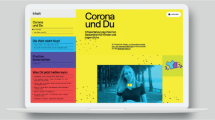Abstract
Background
Despite the high risk of developing a mental disorder during adolescence, many young people fail to receive appropriate treatment from mental health professionals. Recent studies have found certain mental health information websites have improved mental health literacy and reduced symptoms of depression. However, studies exploring young people’s perceptions of such resources still remain scarce. The current paper compared young people’s preference for a website with self-help books and two face-to-face services—counselling and mental health services. The factors associated with believing in the perceived helpfulness of each intervention were also explored.
Method
A national telephone survey was carried out with 3,746 people aged 12–25 years and 2005 co-resident parents. Perceived helpfulness of each intervention was assessed in relation to four vignettes (depression, social phobia, psychosis and depression with alcohol misuse).
Results
Approximately 71% of respondents rated websites and books as likely to be helpful, which was less than for counselling, but more than for mental health services. Predictors of rating a website as likely to be helpful were older age (18–25 years), belief in seeking help, less social distance from peers like the one in the vignette, and being presented with the vignettes depicting either social phobia or depression with alcohol misuse. Predictors of rating a book as helpful included belief in seeking help, awareness of the national depression initiative beyondblue, less social distance, being presented with the social phobia vignette, and the belief that the person in the vignette is ‘weak not sick’.
Conclusion
Most young people are open to the idea of accessing mental health information online, especially for disorders that are often perceived as behavioural problems. These young people also believe in help-seeking in general and are more willing to associate with peers who have mental health problems.
Similar content being viewed by others
References
Adams SJ, Pitre NL (2000) Who uses bibliotherapy and why? A survey from an underserviced area. Can J Psychiatry 45:645–649
Campbell LF, Smith TP (2003) Integrating self-help books into psychotherapy. J Clin Psychol 59:177–186
Christensen H, Griffiths KM, Jorm AF (2004) Delivering interventions for depression by using the internet: randomised controlled trial. BMJ 328:265
Conus P, McGorry PD (2002) First-episode mania: a neglected priority for early intervention. Aust NZ J Psychiatry 36:158–172
Corrigan PW, Green A, Lundin R, Kubiak MA, Penn DL (2001) Familiarity with and social distance from people who have serious mental illness. Psychiatr Serv 52:953–958
Crisp AH, Gelder MG, Rix S, Meltzer HI, Rowlands OJ (2000) Stigmatisation of people with mental illnesses. Br J Psychiatry 177:4–7
Eysenbach G, Kohler C (2004) Health-related searches on the internet. JAMA 291:2946
Griffiths KM, Christensen H (2000) Quality of web based information on treatment of depression: cross sectional survey. BMJ 321:1511–1515
Griffiths KM, Nakane Y, Christensen H, Yoshioka K, Jorm AF, Nakane H (2006) Stigma in response to mental disorders: a comparison of Australia and Japan. BMC Psychiatry 6:21
Griffiths KM, Christensen H, Jorm AF (2008) Predictors of depression stigma. BMC Psychiatry 8:25
Jorm AF, Wright A (2008) Influences on young people’s stigmatising attitudes towards peers with mental disorders: national survey of young Australians and their parents. Br J Psychiatry 192:144–149
Jorm AF, Christensen H, Griffiths KM (2006) Changes in depression awareness and attitudes in Australia: the impact of beyondblue: the national depression initiative. Aust NZ J Psychiatry 40:42–46
Jorm AF, Wright A, Morgan AJ (2007) Where to seek help for a mental disorder? National survey of the beliefs of Australian youth and their parents. Med J Aust 187:556–560
Kessler RC, Amminger GP, Aguilar-Gaxiola S, Alonso J, Lee S, Üstün TB (2007) Age of onset of mental disorders: a review of recent literature. Curr Opin Psychiatry 20:359–364
Leach LS, Christensen H, Griffiths KM, Jorm AF, Mackinnon AJ (2007) Websites as a mode of delivering mental health information: perceptions from the Australian public. Soc Psychiatry Psychiatr Epidemiol 42:167–172
Link BG, Phelan JC, Bresnahan M, Stueve A, Pescosolido BA (1999) Public conceptions of mental illness: labels, causes, dangerousness, and social distance. Am J Public Health 89:1328–1333
Lloyd R, Bill A (2004) Australia online: how Australians are using computers and the internet. 2001 Australian Census Analytic Program. Publication 2056.0. Australian Bureau of Statistics, Canberra
Mackinnon A, Griffiths KM, Christensen H (2008) Comparative randomised trial of online cognitive-behavioural therapy and an information website for depression: 12-month outcomes. Br J Psychiatry 192:130–134
Marie D, Miles B (2008) Social distance and perceived dangerousness across four diagnostic categories of mental disorder. Aust NZ J Psychiatry 42:126–133
Millar A (2003) Men’s experience of considering counselling: ‘entering the unknown’. CPR 3:16–24
Montgomery SA, Bakish D, Buller R, Gjerris A, Katschnig H, Lecrubier Y, Lepine JP, Mauri M, Sartorius N, Cameron A, Cassano G, Costa e Silva J, den Boer JA, Freeman C, von Knorring L, Loo H, Nutt D, Rosenberg R (1996) ECNP position paper on social phobia proceedings from an ECNP workshop in Jerusalem, October 1994. Eur Neuropsychopharmacol 6:77–83
Patel V, Flisher AJ, Hetrick S, McGorry P (2007) Mental health of young people: a global public-health challenge. Lancet 369:1302–1313
Rickwood DJ, Deane FP, Wilson CJ (2007) When and how do young people seek professional help for mental health problems? Med J Aust 187:S35–S39
Schomerus G, Matschinger H, Angermeyer MC (2006) Alcoholism: illness beliefs and resource allocation preferences of the public. Drug Alcohol Depend 82:204–210
Author information
Authors and Affiliations
Corresponding author
Rights and permissions
About this article
Cite this article
Oh, E., Jorm, A.F. & Wright, A. Perceived helpfulness of websites for mental health information. Soc Psychiat Epidemiol 44, 293–299 (2009). https://doi.org/10.1007/s00127-008-0443-9
Received:
Revised:
Published:
Issue Date:
DOI: https://doi.org/10.1007/s00127-008-0443-9




